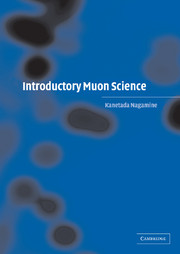Book contents
- Frontmatter
- Contents
- Preface
- List of abbreviations
- 1 What are muons? What is muon science?
- 2 Muon sources
- 3 Muons inside condensed matter
- 4 The muonic atom and its formation in matter
- 5 Muon catalyzed fusion
- 6 Muon spin rotation/relaxation/resonance: basic principles
- 7 Muon spin rotation/relaxation/resonance: probing microscopic magnetic properties
- 8 Muon spin rotation/relaxation/resonance: probing induced microscopic systems in condensed matter
- 9 Cosmic-ray muon probe for internal structure of geophysical-scale materials
- 10 Future trends in muon science
- Further reading
- Index
- References
8 - Muon spin rotation/relaxation/resonance: probing induced microscopic systems in condensed matter
Published online by Cambridge University Press: 22 October 2009
- Frontmatter
- Contents
- Preface
- List of abbreviations
- 1 What are muons? What is muon science?
- 2 Muon sources
- 3 Muons inside condensed matter
- 4 The muonic atom and its formation in matter
- 5 Muon catalyzed fusion
- 6 Muon spin rotation/relaxation/resonance: basic principles
- 7 Muon spin rotation/relaxation/resonance: probing microscopic magnetic properties
- 8 Muon spin rotation/relaxation/resonance: probing induced microscopic systems in condensed matter
- 9 Cosmic-ray muon probe for internal structure of geophysical-scale materials
- 10 Future trends in muon science
- Further reading
- Index
- References
Summary
As mentioned at the beginning of Chapter 7, there have been two different attitudes in the experimenter's mind concerning the role of the μ+ in condensed matter, as shown schematically in Figure 8.1(a): at one extreme, the μ+ is treated as a gentle and passive probe to probe the condensed matter with minimal perturbation and to observe its intrinsic properties prior to the introduction of μ+; at the other extreme, the μ+ is treated as a violent and active probe introducing a perturbation in the host material so as to study new physics and chemistry created by the presence of the μ+. In this chapter, representative studies utilizing the second category, including similar studies of the μ−, are described.
The role of this type of muon spin rotation/relaxation/resonance (μSR) studies is quite significant in its contribution to the growth of our human daily life: (1) the localization and diffusion of the light hydrogen isotope Mu (μ+ e−) simulates a behavior of a dilute hydrogen atom in metals and other condensed matter which is quite difficult to monitor and important in various aspects of industrial constructions ; (2) a trace impurity hydrogen-like atom can “passivate” electrical activity of donors and acceptors or “hydrogenate” dangling bonds in semiconductors ; (3) the lightest hydrogen atom can explore the most fundamental mechanism of hydrogen chemical reaction in terms of mass dependence ; (4) the electron brought in by the energetic light hydrogen can be used to probe electron transport in conducting polymers and biological macromolecules.
- Type
- Chapter
- Information
- Introductory Muon Science , pp. 142 - 169Publisher: Cambridge University PressPrint publication year: 2003

